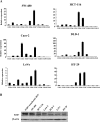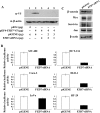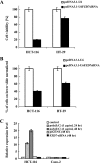Frizzled-7 as a potential therapeutic target in colorectal cancer
- PMID: 18592008
- PMCID: PMC2435005
- DOI: 10.1593/neo.08320
Frizzled-7 as a potential therapeutic target in colorectal cancer
Abstract
We investigated whether one of the Wnt receptors, frizzled-7 (FZD7), functions in the canonical Wnt signaling pathway of colorectal cancer (CRC) cells harboring an APC or CTNNB1 mutation and may be a potential therapeutic target for sporadic CRCs. The expression level of FZD gene family members in colon cancer cells and primary CRC tissues were determined by real-time PCR. Activation of the Wnt signaling pathway was evaluated by TOPflash assay. The expression level of Wnt target genes was determined by real-time polymerase chain reaction and/or Western blot analysis. Cell growth and cell invasion were assessed by MTS and matrigel assays, respectively. Among 10 FZD gene family members, FZD7 mRNA was predominantly expressed in six colon cancer cell lines with APC or CTNNB1 mutation. These six cell lines were transfected with FZD7 cDNA together with a TOPflash reporter plasmid, resulting in a 1.5- to 24.3-fold increase of Tcf transcriptional activity. The mRNA expression levels of seven known Wnt target genes were also increased by 1.5- to 3.4-fold after transfection of FZD7 cDNA into HCT-116 cells. The six cell lines were then cotransfected with FZD7-siRNA and a TOPflash reporter plasmid, which reduced Tcf transcriptional activity to 20% to 80%. FZD7-siRNA was shown to significantly decrease cell viability and in vitro invasion activity after transfection into HCT-116 cells. Our present data demonstrated that FZD7 activates the canonical Wnt pathway in colon cancer cells despite the presence of APC or CTNNB1 mutation and that FZD7-siRNA may be used as a therapeutic reagent for CRCs.
Figures





Similar articles
-
Down-regulation of frizzled-7 expression decreases survival, invasion and metastatic capabilities of colon cancer cells.Br J Cancer. 2009 Oct 20;101(8):1374-81. doi: 10.1038/sj.bjc.6605307. Epub 2009 Sep 22. Br J Cancer. 2009. PMID: 19773752 Free PMC article.
-
Possible involvement of Wnt11 in colorectal cancer progression.Mol Carcinog. 2013 Mar;52(3):207-17. doi: 10.1002/mc.21845. Epub 2011 Dec 7. Mol Carcinog. 2013. PMID: 22161723
-
Frizzled7 as an emerging target for cancer therapy.Cell Signal. 2012 Apr;24(4):846-51. doi: 10.1016/j.cellsig.2011.12.009. Epub 2011 Dec 13. Cell Signal. 2012. PMID: 22182510 Free PMC article. Review.
-
Frizzled7 Promotes Epithelial-to-mesenchymal Transition and Stemness Via Activating Canonical Wnt/β-catenin Pathway in Gastric Cancer.Int J Biol Sci. 2018 Feb 12;14(3):280-293. doi: 10.7150/ijbs.23756. eCollection 2018. Int J Biol Sci. 2018. PMID: 29559846 Free PMC article.
-
Wnt Signaling in Cancer: Not a Binary ON:OFF Switch.Cancer Res. 2019 Dec 1;79(23):5901-5906. doi: 10.1158/0008-5472.CAN-19-1362. Epub 2019 Aug 20. Cancer Res. 2019. PMID: 31431458 Free PMC article. Review.
Cited by
-
Wnt pathway inhibition via the targeting of Frizzled receptors results in decreased growth and tumorigenicity of human tumors.Proc Natl Acad Sci U S A. 2012 Jul 17;109(29):11717-22. doi: 10.1073/pnas.1120068109. Epub 2012 Jul 2. Proc Natl Acad Sci U S A. 2012. PMID: 22753465 Free PMC article.
-
CircRNA_Maml2 promotes the proliferation and migration of intestinal epithelial cells after severe burns by regulating the miR-93-3p/FZD7/Wnt/β-catenin pathway.Burns Trauma. 2022 Mar 7;10:tkac009. doi: 10.1093/burnst/tkac009. eCollection 2022. Burns Trauma. 2022. PMID: 35265724 Free PMC article.
-
Wnt/β-catenin signaling in cancers and targeted therapies.Signal Transduct Target Ther. 2021 Aug 30;6(1):307. doi: 10.1038/s41392-021-00701-5. Signal Transduct Target Ther. 2021. PMID: 34456337 Free PMC article. Review.
-
Frizzled proteins are colonic epithelial receptors for C. difficile toxin B.Nature. 2016 Oct 20;538(7625):350-355. doi: 10.1038/nature19799. Epub 2016 Sep 28. Nature. 2016. PMID: 27680706 Free PMC article.
-
Soluble Frizzled-7 receptor inhibits Wnt signaling and sensitizes hepatocellular carcinoma cells towards doxorubicin.Mol Cancer. 2011 Feb 11;10:16. doi: 10.1186/1476-4598-10-16. Mol Cancer. 2011. PMID: 21314951 Free PMC article.
References
-
- Moon RT, Kohn AD, De Ferrari GV, Kaykas A. WNT and β-catenin signalling: diseases and therapies. Nat Rep Genet. 2004;5:691–701. - PubMed
-
- Clevers H. Wnt/β-catenin signaling in development and disease. Cell. 2006;127:469–480. - PubMed
-
- Segditsas S, Tomlinson I. Colorectal cancer and genetic alterations in the Wnt pathway. Oncogene. 2006;25:7531–7537. - PubMed
-
- Suzuki H, Watkins DN, Jair KW, Schuebel KE, Markowitz SD, Chen WD, Pretlow TP, Yang B, Akiyama Y, Van Engeland M, et al. Epigenetic inactivation of SFRP genes allows constitutive WNT signaling in colorectal cancer. Nat Genet. 2004;36:417–422. - PubMed
Publication types
MeSH terms
Substances
LinkOut - more resources
Full Text Sources
Other Literature Sources
Medical
Molecular Biology Databases
Research Materials
Miscellaneous
